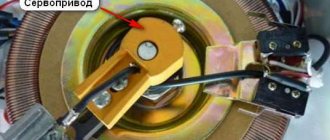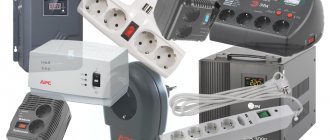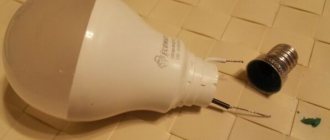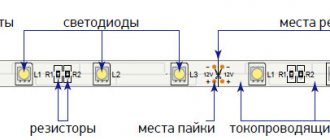Sudden surges and power outages can cause damage and even breakdown of expensive equipment that is sensitive to voltage surges.
generators that can provide equipment with stable autonomous power will allow you to avoid troubles .
How to choose such a device and which models of inverter generators are the best today, we will consider in the review.
Work principles
In terms of its performance characteristics, this generator is similar to a simple gasoline generator. However, there is a significant difference: the current does not reach the output directly from the current collectors, but undergoes a double conversion. As a result, a sinusoid of ideal shape is formed with equalized characteristics of force and standard voltage.
Operating principle of the inverter
Thanks to these operating principles, inverter gas generators provide devices with current with stable characteristics, which significantly increases the service life of sensitive high-precision equipment.
Equipment design
A portable inverter-type station is based on the operation of a special unit, which consists of:
- Converter;
- Rectifier;
- Microprocessor.
The function of the rectifier is to convert alternating current into direct current.
Next, using special filters, the constant oscillation frequency is again converted into a variable frequency and supplied to the connected equipment. As a result of the operation of the inverter gas generator, uninterrupted operation of any high-precision equipment is ensured, and lighting fixtures will not flicker.
Ignition system
As for the launch system, it can be manual or automatic. In the first option, the installation is turned on by a manual or electric starter directly on site. In the latter case, it is possible to organize a remote start after a small modification (if this function was not provided by the manufacturer).
In the second embodiment, the generator starts working when the centralized power supply is turned off. Stations with automatic start are the most reliable option for emergency power supply for a summer house or country house.
Inverter generator
An inverter generator has a completely different way of generating electrical energy, although it is still the same alternating current device. It does not supply electricity directly, as happens in the classic model. Its design contains several intermediate components, the main one of which is the battery.
How is electrical alternating current generated?
- At first, everything happens the same as in a classic device. That is, the internal combustion engine rotates a shaft that is connected to the alternator rotor. The latter produces alternating current.
- The current passes through the power electronics and becomes DC. They charge the battery.
- Now, in order to get alternating current again, an inverter is installed after the battery, which produces a current of the required voltage, or rather, 220 volts with a frequency of 50 Hz.
Why is such a complex scheme necessary, what is its advantage? Everything again comes down to hydrocarbon fuel consumption. For such a unit there is no need to maintain a constant rotor speed; it can be quite small, and this will be enough to charge the battery. True, with reduced rotation the charging time will increase
But in this case it is not so important. It turns out that the lower the rotation speed, the less fuel is consumed
In addition, we can say that it is this parameter that affects the size of the generator. It becomes compact and lightweight. Plus - it's silent operation.
Flaws
In principle, there are two main disadvantages:
- Cost of equipment. It is almost twice as high as the classic ones.
- Design feature - the battery is an integral and non-separable part of the generator. That is, if the battery life has expired, you will have to replace the entire device.
Inverter generator design
As for the battery, there is another negative point. Its capacity may not support the required amount of electricity consumption. That is, you initially expected a certain load in the electrical network at home, but after a few months it increased. In this case, the battery will quickly discharge, and charging will be slow; it will not be enough for the power consumption. You will have to turn off the generator, wait for the battery to charge, after which you can use the electrical network. Let's face it, it's inconvenient.
Which company should you choose?
It is impossible to call any particular company the permanent leader in terms of sales or reliability.
Sufficiently powerful, compact and inexpensive generators are produced by Russian companies Energomash and Svarog . They are perfect for powering small objects.
More powerful and professional “cars” are produced by the German company Fubag, South Korean Hyundai and Japanese Honda. The middle position is occupied by the manufacturers Elitech, Patriot and ZUBR - they are productive, versatile and affordable.
What is an inverter generator and why is it better than a regular one?
When it comes to mobile diesel generators, such equipment usually means a fairly simple design consisting of a diesel engine and an alternating current electric generator (alternator).
The quality and performance of these components directly affects such important characteristics of the device as reliability, efficiency, and size. The level of noise produced and of course the cost.
Many people believe that the diesel engine of a generator, which generates electricity, is its main part and the more powerful the engine, the more electrical power the electric generator can produce. In reality, alternators of different types of generators are devices that produce electricity in different ways.
A conventional diesel generator uses the engine to rotate at a single frequency (usually 3600 rpm). The quality of the generated energy depends on the stability of the engine.
An inverter generator operates on a different principle. Initially, the alternator of the inverter generator produces voltage with a frequency of 20 Hertz, after which it converts it into DC voltage, and in the third stage, the DC voltage is converted into AC voltage with the required frequency using power electronics.
A device that converts alternating current of one frequency and voltage into current of another frequency and voltage is called an inverter. It must be said that recently, this device is being used more and more often, as it can significantly save energy, as well as reduce the noise produced by mechanical parts (for example, a diesel engine).
The advantages of an inverter generator are that it does not require a constant rotation speed of the alternator rotor to produce electricity. This allows you to significantly reduce the noise produced by the device, as well as significantly more optimal fuel consumption, which is why renting a diesel generator with an inverter is much cheaper. In addition, an inverter generator produces a higher quality voltage than a conventional generator.
All these advantages are somehow reflected in the cost of inverter generators, which is significantly higher than that of conventional ones. Based on this, buying or renting an inverter generator is advisable when there is a need to supply electricity to devices sensitive to the quality of electricity (computers, televisions, telephones). An inverter generator is an excellent solution for organizing a backup power supply system for a country house.
Another distinctive characteristic of inverter diesel generators is their very low noise level. Therefore, this type of generator is very well suited for organizing power supply for concert equipment at small outdoor parties or banquets.
However, despite all the advantages, the inverter generator also has its disadvantages. The service life of such a device is lower than that of a conventional generator. This is primarily due to the abundance of electronics in the design of this device, which also imposes restrictions on the temperature at which it is recommended to use this technique.
In conditions where you need to use a generator constantly, it is best to buy a classic generator, as it is more durable in operation. It is also less sensitive to temperature changes in the external environment. In addition, if the device suddenly fails, repairing a conventional generator will cost much less than inverter models.
Detailed information about fubag generators is on our website.
Video
What is the difference between a drill and a hammer drill?
XXI CENTURY Candy Fudge Scented water
266 ₽ More details
Video baby monitor Motorola MBP36S (white)
12900 ₽ More details
Best clothes
Operating principles of inverter generators
An inverter generator can only be purchased if the operating principle is completely clear. Otherwise, exploitation can bring significant discontent and even turn out to be too dangerous.
An inverter generator is traditionally created on the basis of a special unit, which must include a microprocessor, a rectifier, and a converter.
So, what is the operating principle of an inverter generator?
- There is the possibility of generating high-frequency alternating current.
- The rectifier allows you to convert the resulting current into direct current.
- It is assumed that current can be accumulated in capacitive filters, which are produced in the form of batteries.
- There is an opportunity to stabilize the oscillations of electrical waves.
- Inverter generators allow you to convert the energy that comes from capacitive filters into alternating current. In this case, it is assumed that the required frequency and voltage indicators will be achieved. Subsequently, AC power must be supplied to the end user. As a result of the working process, you can see an ideal sine wave, which guarantees that the quality of the received electricity is maintained at optimal level.
The above operating principles make it possible to obtain a stable voltage, which ensures protection for very sensitive devices. It should be noted that inverter generators can operate automatically.
The cost of refueling equipment can be halved thanks to full and constant control over the level of fuel, oil, as well as the performance of the running engine.
The design features of modern generators make it possible to guarantee a high level of equipment protection. For this purpose, a built-in air cooling system is traditionally used. However, if the load is reduced to a minimum level, an automatic transition to an economical mode is expected, as a result of which rapid wear of the equipment can be avoided and maximum service life can be guaranteed.
Is it possible to connect a welding machine to a gas generator?
Welding machines are used in many areas of human activity. They help solve problems in everyday life in a country house, in small manufacturing enterprises, in auto repair shops, and in large industrial facilities.
Welding is especially in demand on construction sites, where until recently heavy transformer welding machines were used. They are large in size, such a unit must be transported by road.
Transformer welding is problematic to move around the construction site.
Welding process
Generator types
Manufacturers make generators for various purposes. The best option is to choose an inverter-type gasoline generator, especially for welding machines. Preferably from the same manufacturer as the welding machine.
A gasoline generator using inverters produces a very stable high-frequency voltage and current. This ensures high quality welding and a long service life of the welding machine.
Generators are divided into three types:
- Industrial models of gas generators are used in metal structures manufacturing plants that operate full time or around the clock. They have high welding currents, the connecting seams are very high quality. For such inverters, you need to choose a gasoline generator capable of delivering currents of 250-500 A.
Model of industrial inverter gas generator
- Professional models of medium power are used by housing and communal services workers, construction workers, and emergency services employees.
Professional inverter gas generator
- Low-power household ones, for short-term work, require generators with an output current of 130–200 A.
Depending on the tasks performed and operating conditions, it is necessary to select a generator taking into account the following factors:
- weight;
- dimensions;
- transportation methods;
- number of generator options;
- the length of the wires from the generator to the welding inverter (with a length of more than 15 m, the voltage and power begin to decrease);
- what type of generator, three or single phase output voltage;
- Of great importance in terms of safety is the option to reduce the voltage in idle mode.
Small-sized, lightweight, portable, gasoline inverter generators are in great demand among household consumers. The forum of the portal about welding equipment on the Internet reveals questions about which country and manufacturer of generators are better.
. Generator welding
From the above information it is clear that for domestic short-term work it is enough to take a gasoline inverter generator slightly higher than the calculated average power consumption of the inverter welding machine.
By setting the welding current on the panel to medium or slightly higher power, you can carry out high-quality welding work with electrodes up to 3 mm Ø. This will save money on purchasing a generator.
In other cases, it is better to choose an industrial or professional inverter gas generator.
When choosing generators of this group, the power is calculated based on the maximum power consumed by the welding machine plus 30–40%.
Only such conditions will ensure high-quality welding and long-term operation of the equipment.
- Registration: 04/10/08 Messages: 9 Thanks: 3 Good time everyone! I bought a Greenfield 3600 gas generator for my dacha and garage. At the dacha on weekends, the mains voltage is 150. Please tell me what kind of welding inverter I can buy so that the generator does not burn out and the welding works in normal mode? Budget 9000-11000 rub.
- Predatory_Mouse
I recommend reading here:
Classification of petrol power plants
Depending on the resource of installations and power, they are usually divided into household, professional and stationary. The first ones, as a rule, are designed to operate no more than 3 hours a day (for example, Navigator SPG 2700, as well as the model range of such manufacturers as Ergomax, Technic, Wester, Megavolt, Genctab, etc.).
), the latter can function continuously for at least 8 hours. To increase service life, cast iron liners are installed in the engine cylinders. When operating for more than eight hours, it is not advisable to use gasoline units; it is cheaper to switch to stations with a diesel drive.
Household generator Firman SPG3800
Household appliances are limited to a power of 4 kW, but there are also more powerful generators in this class. Examples include Fubag bs 6600, Ultra PG 3200, Kipor KDE6500E3.
The power of professional units, as a rule, does not exceed 15 -16 kW; such stations can be found in the model range of Shtenli, Etalon, Genset, Skat, TNG, etc. An example of such a setup is presented below.
Power plant Robin Subaru EB 14.0/230-SLE 14 kW 380V (3 phases)
More powerful units (up to 30 kW) are available in a stationary version. As a rule, such models are launched both automatically and manually. At power plants with a power of 30 kW or more, installing a gasoline engine is unprofitable due to its short service life and high fuel consumption. That is why powerful generators are driven by a diesel engine.
Stationary gasoline power plant Vepr ABP 20-T400/230 VK-BS (20 kW, with autostart, 400/230 V, 3-phase, made in Russia)
Classic gas generator
The operating principle of this model is simple. Carbon-type fuel enters a classic engine capable of running on gasoline or diesel fuel, which causes the shaft to move. The latter is combined with the alternator. This device is an electric generator capable of converting mechanical force into electricity through windings and magnetic elements.
A conventional gasoline generator for home use is devoid of intermediaries, which allows the rotor to rotate at the same speed. As the rotational motion decreases or increases, the performance of the gas generator and the amount of current generated increases or decreases. This is the disadvantage of the classic device, since wear of the moving elements is inevitable, which leads to a decrease in speed over time.
It is also important for buyers to remember that devices of this type have an additional economic disadvantage. So, at low load, which is below the nominal level, excessive fuel consumption begins
This point is especially noticeable when the gas generator operates in this mode for several hours.
Comparison of the distinctive properties of generators
Regular models
Pros:
- Large selection of power units.
- Reliability of generators. This is understandable - the simpler the design of any installation, the fewer problems there are with it.
- Lower price compared to inverter analogues. For example, the cost of a regular 1.2 kW model ranges from 14,260 – 16,180 rubles (depending on the manufacturer and series).
Minuses:
Instability of the generated voltage with some (over time) decrease in its nominal value. The main reason is the gradual wear of parts, which is reflected in the speed of rotation of the rotor. It is decreasing. Therefore, when operating a conventional generator, you have to periodically increase the speed, and this means additional fuel consumption. Such models require optimal load
By the way, rarely does anyone pay attention to this point when choosing a generator in a conventional, traditional design. First of all, due to ignorance of the specifics of its work
If you carefully read the instructions from the manufacturer (and almost no one does this, either at the point of sale or at home), it will become clear that all its parameters correspond to certain operating conditions. Namely, the minimum load is 25%. This is the limit. Only a few hours are allowed throughout the year, nothing more. If it is systematically less, then the service life of the unit (repair-free) is reduced. But fuel consumption will be more than calculated.
For example, if the total power of consumers on the line is 2.2 kW, and the generator itself is 4, then it will “eat” fuel at the rate of four. That is, almost half of the installation is running idle. In practice, this is usually what happens – regular “underloading”.
The accumulation of combustion products (soot) inside the engine also leads to increased consumption, that is, the problem of premature maintenance and repair comes up again.
It turns out that an incorrectly selected load on a conventional generator is fraught with a whole “package” of problems. Consequently, saving on its cost, the owner in the future loses on fuel and spare parts. And part of my free time too. How justified this is is for you, the reader, to judge. Especially when you consider that the generator is purchased for systematic (or even constant) use for many years.
Inverter models
Pros:
- Economical. There is no need to increase the rotation speed of the motor shaft. It only affects the battery charging time. This achieves optimization of fuel consumption.
- When the load changes, the output voltage rating remains constant. This stability is due to the presence of an electronic converter circuit.
- Silence. For an inverter generator, you do not need to choose a location as for a conventional model. Even installed in a neighboring utility room, through a thin partition, it will not disturb the household.
- Compact and light weight. The inverter generator can be easily reinstalled within a house or site, or transported over a distance (for example, to a country house). That is, unlike conventional units, such installations are mobile.
Minuses:
Customer Reviews
Artem
Honda EU10i, (1000 W)
Purchased over 10 years ago for work. Over the years, it has hardly worked more than 100 hours, which means we use it very rarely. Easy to start, nothing broke, quiet compared to other portable generators. If you use it for a laptop and charging gadgets, then it works for about 8 hours on one tank. I change the oil either once a year or before use if more than a year has passed without use. You need approximately 120-150 ml of oil. After draining the old oil, about 100 ml of new oil is poured in, but after that it usually does not start and the oil pressure symbol lights up, then you need to add another 20-50 ml. I measured the weight of the Honda without gasoline, but with oil. It turned out to be a little over 13 kilograms! It turns out that the rated weight of 16 kg is with fuel. And Chinese competitors indicate dry weight at the docks. Honda won almost 4 kg here too!











